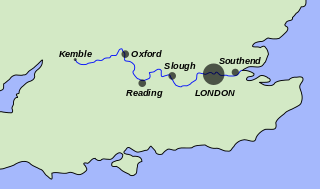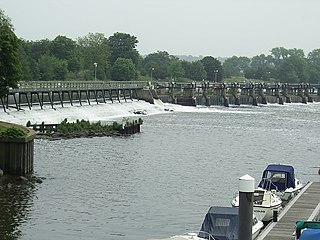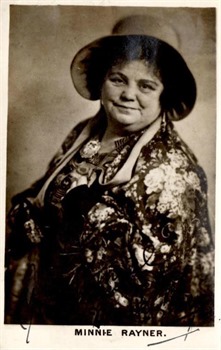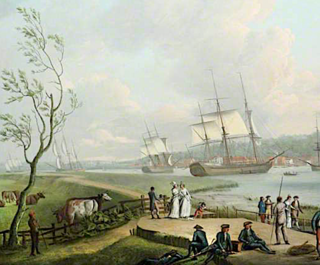Related Research Articles

The River Thames, known alternatively in parts as the River Isis, is a river that flows through southern England including London. At 215 miles (346 km), it is the longest river entirely in England and the second-longest in the United Kingdom, after the River Severn.

Hampton is a suburb of Greater London on the north bank of the River Thames, in the London Borough of Richmond upon Thames, England, and the historic county of Middlesex. Hampton is bounded by Bushy Park to the east, the suburbs of Hampton Hill and Fulwell to the north, green belt to the west, and the Thames to the south.

Twickenham is a suburban district in London, England. It is situated on the River Thames 9.9 miles (15.9 km) southwest of Charing Cross. Historically part of Middlesex, it has formed part of the London Borough of Richmond upon Thames since 1965, and the borough council's administrative headquarters are located in the area.
Richmond is a town in south-west London, 8.2 miles (13.2 km) west-southwest of Charing Cross. It stands on the River Thames, and features many parks and open spaces, including Richmond Park, and many protected conservation areas, which include much of Richmond Hill. A specific Act of Parliament protects the scenic view of the River Thames from Richmond.

The Tideway is a part of the River Thames in England which is subject to tides. This stretch of water is downstream from Teddington Lock. The Tideway comprises the upper Thames Estuary including the Pool of London.

Hammerton's Ferry is a pedestrian and cycle ferry service across the River Thames in the London Borough of Richmond upon Thames, London, England. The ferry links the river's northern bank near Marble Hill House in Twickenham with its southern bank near Ham House in Ham. It is one of only four remaining ferry routes in London not to be replaced by a bridge or tunnel.

The Sleeping Cardinal, also known as Sherlock Holmes' Fatal Hour in the United States, is a 1931 British mystery film directed by Leslie S. Hiscott and starring Arthur Wontner and Ian Fleming. The film is an adaptation of the Sherlock Holmes stories by Arthur Conan Doyle. Although it is not based on any one particular story, the film draws inspiration from "The Empty House" and "The Final Problem". The film is the first in the 1931–1937 film series starring Wontner as Sherlock Holmes. It is unrelated to the Basil Rathbone series of Sherlock Holmes films that began in the late 1930s.

Beauty and the Barge is a 1937 British comedy film directed by Henry Edwards and starring Gordon Harker, Judy Gunn and Jack Hawkins. It was produced by Julius Hagen's production company Twickenham Film Studios, but made at the Riverside Studios in Hammersmith rather than at Twickenham. It was based on the 1905 play Beauty and the Barge by W. W. Jacobs.

George Carney was a British comedian and film actor.

Minnie Rayner was a British stage and film actress.
Commissionaire is a 1933 British crime film directed by Edward Dryhurst and starring Sam Livesey, Barry Livesey and George Carney. It was shot at Cricklewood Studios as a quota quickie for release by MGM.

The Lad is a 1935 British comedy film directed by Henry Edwards and starring Gordon Harker, Betty Stockfeld and Jane Carr. It was made at Twickenham Studios. The film is based on a novel by Edgar Wallace.
Janice Adair was a British film actress of the early sound era. She was married to the film editor Alfred Roome.
Contraband Love is a 1931 British crime film directed by Sidney Morgan and starring C. Aubrey Smith, Janice Adair and Haddon Mason. It was made at British and Dominions Elstree Studios and on location in Cornwall. The film was distributed by the American studio Paramount Pictures as a quota quickie.
The Small Man is a 1936 British drama film directed by John Baxter and starring George Carney, Minnie Rayner and Lilian Oldland. It was made at Cricklewood Studios.
Lest We Forget is a 1934 British drama film directed by John Baxter and starring Stewart Rome, George Carney and Esmond Knight. It was made as a quota quickie at Shepperton Studios.
Music Hall is a 1934 British musical drama film directed by John Baxter and starring George Carney, Ben Field and Mark Daly. It was made at Twickenham Studios as a quota quickie.
To What Red Hell is an all-talking sound 1929 British crime film directed by Edwin Greenwood and starring Sybil Thorndike, Bramwell Fletcher and Janice Adair. Made at Twickenham Studios, it was one of the earliest all-talking sound films to be produced in Britain.

The Embanking of the tidal Thames is the historical process by which the lower River Thames, at one time a broad, shallow waterway winding through malarious marshlands, has been transformed by human intervention into a deep, narrow tidal canal flowing between solid artificial walls, and restrained by these at high tide. The Victorian civil engineering works in central London, usually called "the Embankment", are just a small part of the process.
References
- ↑ Wood p.82